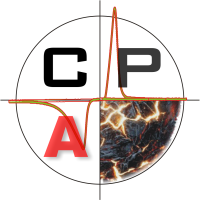
Journal of
Corrosion and Anticorrosion Protection


 Volume III, Issue 1, 2008
Volume III, Issue 1, 2008
 Home
Home------------------------------
 About
Us
About
Us ------------------------------
 Authors Guide
Authors Guide------------------------------
 Subscription
Subscription-----------------------------
 News
News-----------------------------
 Contact
Us
Contact
UsContent



Viorel BRÂNZOI  ,
Florentina GOLGOVICI,
Florina BRÂNZOI, Luisa PILAN
,
Florentina GOLGOVICI,
Florina BRÂNZOI, Luisa PILAN
Anticorrosive Effect of Some Polymers Synthesized in Microwave Field
for Industrial Systems Protection
Abstract: Using the microwave energy were obtained by radical polymerization the organic compounds which can be used as corrosion and scaling inhibitors. Using of antiscaling and corrosion inhibitors in industrial systems constitutes a complex procedure with following complementary aims: - Corrosion processes prevention in industrial systems at metal - aqueous solutions interface - Deposits prevention in industrial systems The inhibition action of these organic compounds was studied by using the potentiodynamic method, electrochemical impedance spectroscopy (EIS and metallographic analysis) for corrosion systems: industrial cooling water and OL 37 steel and Monel alloy. Keywords: antiscaling and corrosion inhibitors, microwave field, potentiodynamic polarizations, metallography analysis



B. TUTUNARU, Adriana PĂTRU SAMIDE  , M. PREDA
, M. PREDA
The influence of lipids on the corrosion of 316L stainless steel
Abstract: The electrochemical behavior of 316L stainless steel in Intralipid solution was studied by using potentiostatic measurements, cyclic voltametry (CV) and galvanostatic polarization. The potentiostatic polarization curves show an inhibitor effect of this medium and a passivation domain until 900 mV; cyclic voltametry does not show a hysteresis cycle and pitting corrosion. We think that the lipids molecules are adsorbed on metallic surface; that fact is in according with the corrosion current value obtained by extrapolation of Tafel lines at corrosion potential.



Corina RĂDULESCU, E. ROMAN  , N.
SPĂTARU, Oskar von MULLER
, N.
SPĂTARU, Oskar von MULLER
New corrosion inhibitors for acid scale removal in
thermoenergetic equipments
Abstract: The efficiency of two inhibitors, ENPRO 900 and TRIAV M, was investigated by weight loss and potentiostatic methods for carbon steel corrosion in acidic solutions used for scale removal. It was found that, in H2SO4, HCl and HF solutions, a concentration of 0.3 – 0.5% of inhibitors results in a decrease of the corrosion rate of more than 95%. An efficiency of ca. 80% was found in ammonium monocitrate solutions (pH 3.8 – 4.2). It was observed that these effects are mainly due to a hindrance of the cathodic reaction as a result of inhibitors adsorption.



Alina-Crina CIUBOTARIU  , Lidia
BENEA, Magda LAKATOS-VARSANY
, Lidia
BENEA, Magda LAKATOS-VARSANY
Improving corrosion resistance by nanostructural modification using
co-depoisition of ceramic nano-sized particles with nickel
Abstract: The co-deposition of nano-sized particles during an electroplating process has been shown to bring an improvement of coatings properties. This work focuses on nano-structured composite coatings having MoS2 (30nm) and Al2O3 (13nm) as dispersed phased co-deposited with nickel during electrodeposition process. We present the electrochemical corrosion behaviour of nano-structured composite coatings using the electrochemical impedance spectroscopy and potentiodynamic methods. As test solutions 0.5 M sodium chloride and potassium sulphate we used in a three electrode open cell with nickel based nanostructured composite coatings as working electrode (WE), a platinum gauze as counter electrode (CE) and an Ag/AgCl electrode as reference electrode (RE). From experimental data we observed that corrosion rate (corrosion current) is higher for Al2O3 - Ni coatings in 0.5M K2SO4 (0.5μA cm-2) and smaller for MoS2 – Ni coatings in 0,5M K2SO4 (0.02 μAcm-2).



Lucia STAICU  , George
VERMEŞAN, Gabriela STAICU
, George
VERMEŞAN, Gabriela STAICU
Dental alloys and their corrosion behavior
Abstract: On the basis of results offered by literature, the work presents a review of some type dental alloys corrosive characteristics and its impact on the people health, inclusive measures taken for improve dental alloy biocompatibility.



Ana-Irina SMICAL  , Vasile
HOTEA
, Vasile
HOTEA
Recycling zinc coated steel scrap
Abstract: Steel and zinc are easily recyclable. Zinc coatings lengthen the useful life of steel products and structures and keep the steel performing at its peak condition. When the zinc coated steel is scrapped and recycled the steel and zinc have new lives. Therefore, the combination of steel and zinc is especially fortunate because it is possible to separate and recover both the original metals. This means that galvanized steel and electro-zinc coated steel sheet are recyclable materials which can be reused to make further contributions to the life of the community. The metals can be separated because zinc is naturally much more volatile than steel. When scrap zinc coated sheet is melted in the steel making process, the scrap steel is turned into new steel for reuse. The recycled zinc is also used in zinc coated steel, with a new life in new products, such as cars, buildings and construction products.
 Year
Year
|2010||2009|
|2008|
|2007|
|2006|
The Journal of Corrosion and Anticorrosion Protection is edited by S.C. BETAK S.A.
in collaboration with Technical University of Cluj-Napoca, Romania